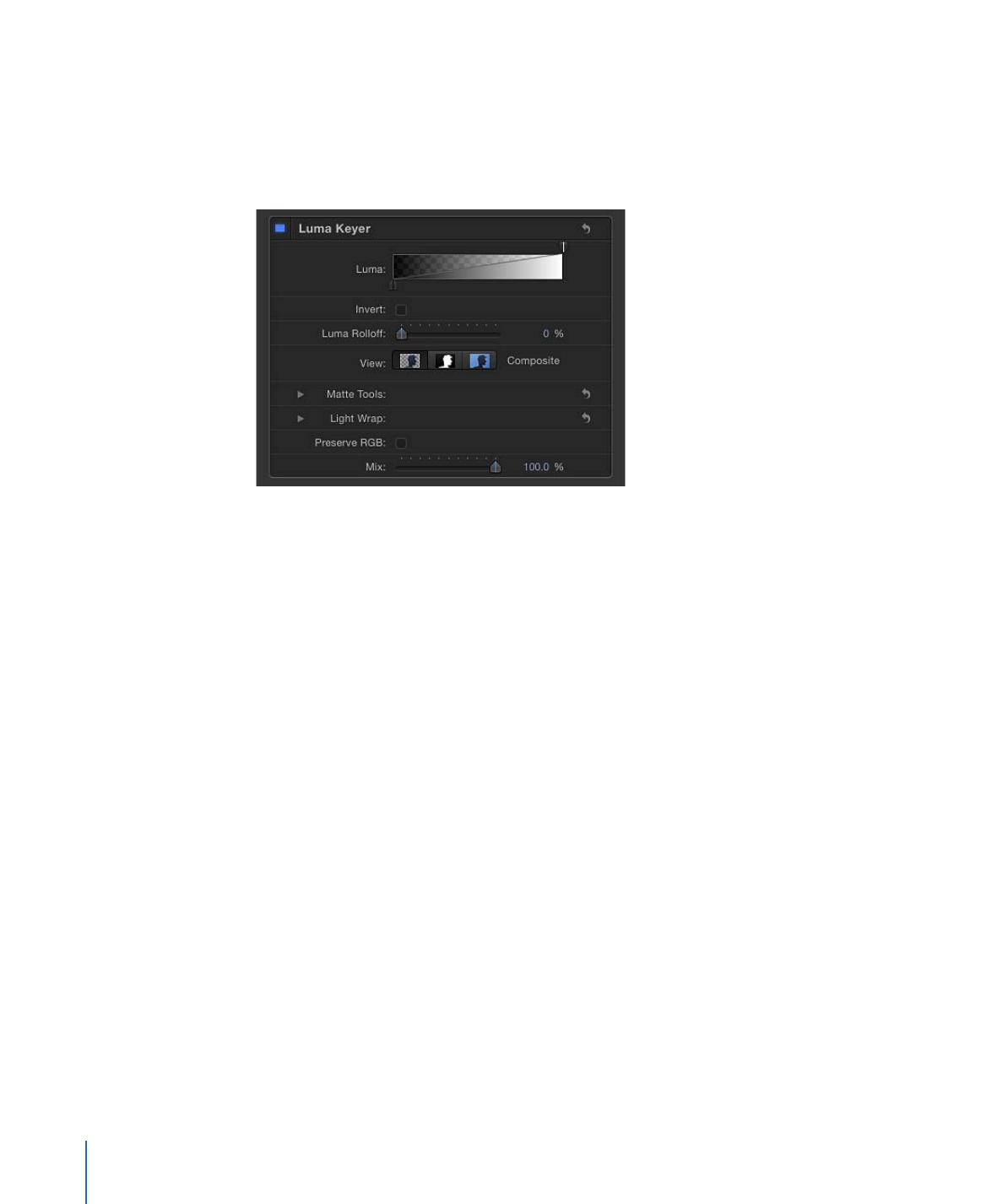
Luma Keyer
The Luma Keyer filter appears to have similar controls to the Keyer filter. However, because
the Luma Keyer generates keys based on a simple range of lightness in an image, rather
than a range of color and lightness, its controls are simpler.
Parameters in the Inspector
Luma:
Drag the handles of this grayscale gradient to adjust tolerance and softness in the
matte. When you first apply the Luma Keyer filter to an image layer in Motion, the Luma
control displays two handles: a Tolerance handle in the upper right, and a Softness handle
in the lower left.
Dragging the top handle to the left reveals a second tolerance handle. Together, these
handles define the range of image lightness used to define the core transparency of the
resulting matte. The range of lightness turned transparent is indicated by a checkerboard
pattern behind the gradient.
Two handles under the gradient define the softness, or edge transparency, of the key.
(The second softness handle may not be visible until you drag the two tolerance handles
left.) Dragging either of the lower softness handles further out and away from the upper
tolerance handles results in a key with softer edges. You can also drag the slope in the
graph to adjust the softness handles.
Invert:
Select this checkbox to reverse which area is transparent and which is opaque.
658
Chapter 13
Keying

Luma Rolloff:
Use this slider to adjust the linearity of the falloff between the Luma control’s
tolerance and softness handles. Modifying this parameter changes the softness of the
matte around the edges in regions that are affected most by the Luma control. Decreasing
the Luma Rolloff value makes the slope between the two handles of the Luma control
more linear, which visibly increases edge softness. Increasing this value makes the slope
between the handles of the Luma control steeper, sharpening the edges of the matte
and making them more abrupt.
View:
Use these buttons to switch among three keying preview modes in the Canvas,
useful for refining your key.
• Composite: When selected, the leftmost button displays the final composited image
in the Canvas, with the keyed foreground subject isolated against a transparent
background, which lets layers underneath show through.
• Matte: When selected, the middle button displays the grayscale matte, or alpha channel,
generated by the keying operation. Viewing the alpha channel lets you evaluate the
parts of the generated matte. Areas in the matte that appear white are visible in the
final composite; areas that appear black are transparent; and areas with shades of gray
are semitransparent (lighter grays being more solid, and darker grays being more
translucent). Viewing the alpha channel makes it easier to spot unwanted holes in the
key, or areas of the key that aren’t transparent enough.
• Original: When selected, the rightmost button displays the original, unkeyed image in
the Canvas.
Matte Tools:
Click the disclosure triangle in the Matte Tools row to reveal controls for
post-processing the transparency matte generated by the previous sets of parameters.
These parameters do not alter the range of values sampled to create the keyed matte.
Instead, they alter the matte generated by the Luma and Luma Rolloff controls, letting
you shrink, expand, soften, or invert the matte to achieve a better composite.
• Fill Holes: Use this slider to adjust solidity in regions of marginal transparency throughout
a key. This parameter is useful when you’re satisfied with the edges of your keyed matte
but have unwanted holes in the interior of the foreground subject that you can’t
eliminate using the Strength parameter without ruining edges. Higher slider values fill
more holes in the solid areas of the keyed subject.
659
Chapter 13
Keying

• Edge Distance: Use this slider to adjust how close to the edge of your keyed subject
the effect of the Fill Holes parameter gets. Reducing this parameter brings the solid,
nontransparent area of the matte closer to the edge of the subject being keyed,
sacrificing translucence at the edges in favor of filling unwanted holes at the edge of
the keyed subject, or retrieving areas of semitransparent detail, such as hair, smoke, or
reflections. Raising this parameter pushes the filled area of the matte further to the
interior of the subject, away from the edges, adding translucence to regions of the
image that aren’t being keyed aggressively enough. Raising this parameter too much
can introduce regions of unwanted translucence in parts of the subject that should be
solid.
• Levels: Use this grayscale gradient to alter the contrast of the keyed matte, by dragging
three handles that set the black point, white point, and bias (distribution of gray values
between the black point and white point). Adjusting the contrast of a matte can be
useful for manipulating translucent areas of the key to make them more solid (by
lowering the white point) or more translucent (by raising the black point). Dragging
the Bias handle right erodes translucent regions of the key, while dragging the Bias
handle left makes translucent regions of the key more solid.
• Black, White, Bias: Click the disclosure triangle in the Levels row to reveal sliders for the
Black, White, and Bias parameters. These sliders, which mirror the settings of the Levels
handles described above, allow you to keyframe and apply Parameter behaviors to the
three Levels parameters (via the Add Keyframe button to the right of each slider).
Keyframing the Black, White, and Bias parameters may yield a better key, one that
adapts to changing blue screen or green screen conditions.
• Shrink/Expand: Use this slider to manipulate the contrast of the matte to affect matte
translucence and matte size simultaneously. Drag the slider left to make translucent
regions more translucent while simultaneously shrinking the matte. Drag the slider
right to make translucent regions more solid while simultaneously expanding the matte.
• Soften: Use this slider to blur the keyed matte, feathering the edges by a uniform
amount.
• Erode: Drag this slider to the right to increase edge transparency from the outer edge
of the matte progressively further into the interior of the keyed matte.
Light Wrap:
Click the disclosure triangle in the Light Wrap row to reveal controls for
blending color and lightness values from the background layer of your composite with
the keyed foreground layer. Using these controls, you can simulate the interaction of
environmental lighting with the keyed subject, making it appear as if background light
wraps around the edges of a subject.
In Motion, the Light Wrap operation blends light and dark values from the background
with the edges of the keyed foreground subject, and can be used to create color mixing
effects around the edges of the solid part of a key to better marry the background and
foreground layers of your keyed composite.
660
Chapter 13
Keying

Light Wrap is the last operation in the image-processing pipeline. In other words, the
light-wrap effect is added after every other image operation is processed, including filters,
lights and shading, and other composited effects. As a result, Light Wrap accounts for
any visual effect that might alter the look of the object it is applied to, yielding the most
desirable result.
Important:
A separate Light Wrap option appears in the Blend Mode pop-up menu of
the Properties Inspector for a selected layer or group in Motion. The Light Wrap blend
mode in the Properties Inspector for a layer is ignored when you add a Keyer filter to that
layer and set the Light Wrap Amount parameter to a value greater then 0. (The Light
Wrap parameters of the Keyer filter take precedence.) However, if you set the Amount
parameter of the Light Wrap group to 0, the Light Wrap blend mode becomes active
again. Further, the Light Wrap blend mode in the Properties Inspector for a group overrides
the Light Wrap parameters of any Keyer filters in that group.
• Amount: Use this slider to control the light-wrap effect, setting how far into the
foreground the light wrap extends.
• Intensity: Use this slider to adjust gamma levels to lighten or darken the interaction of
wrapped edge values with the keyed foreground subject.
• Opacity: Use this slider to fade the light wrap effect up or down.
• Mode: Use this pop-up menu to choose the compositing method to blend the sampled
background values with the edges of the keyed subject. There are five modes:
• Normal: Evenly blends light and dark values from the background layer with the
edges of the keyed foreground layer.
• Lighten: Compares overlapping pixels from the foreground and background layers,
then preserves the lighter of the two. Good for creating a selective light wrap effect.
• Screen: Superimposes lighter portions of the background layer over wrapped areas
of the keyed foreground layer. Good for creating an aggressive light wrap effect.
• Overlay: Combines the background layer with the wrapped areas of the keyed
foreground layer so overlapping dark portions become darker, light portions become
lighter, and colors become intensified.
• Hard Light: Acts like the Overlay composite mode, except that colors become muted.
Preserve RGB:
Select this checkbox to preserve smooth graphics and text. Some images
may be rendered as if they have an alpha channel, even though they don’t. A good
example is white text on a black background. Rasterized text in most images is antialiased
properly, and further modification to the RGB channels by the Luma Keyer can degrade
the quality of the edges. Selecting the Preserve RGB checkbox adds transparency to the
image without modifying the RGB channels, leaving smoothly aliased text or graphics
visually intact.
661
Chapter 13
Keying

Mix:
Use this slider to set the percentage of the original image to be blended with the
keyed image. 100% is the fully keyed image, while 0% is the original, unkeyed image.
HUD Controls
The HUD contains the following controls: Luma and Luma Rolloff.